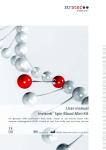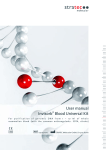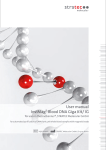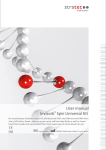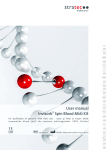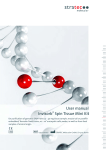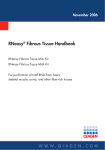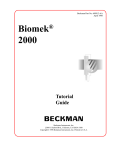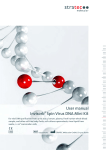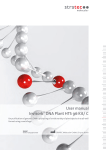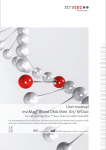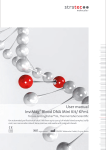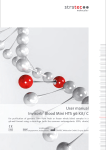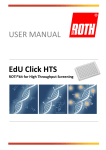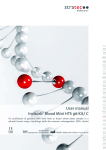Download Invisorb Universal Bacteria HTS 96 Kit/ C User manual
Transcript
User manual Invisorb® Universal Bacteria HTS 96 Kit/ C for purification of bacterial or parasite DNA from different kinds of starting materials in a 96-well format using a centrifuge IVD REF 7033300x00 STRATEC Molecular GmbH, D-13125 Berlin Invisorb® Universal Bacteria HTS 96 Kit The Invisorb® Universal Bacteria HTS 96 Kit is the ideal tool in convenient 96 well format for isolation and purification of bacterial DNA from different clinical specimen, e.g. whole blood, swabs, biopsy material and from cell free body fluids, e.g. urine, serum, plasma and synovial fluids. Invisorb® Universal Bacteria HTS 96 Kit suits to manual and automated*) use. Ultra pure genomic DNA gets purified for enhanced performance in sensitive applications. Additionally, yields of the ready to use DNA are reproducible. Large sample numbers in this 96 well format are handled time-saving. The user can be flexible in his choices in the range of starting material. No cross-contamination will occur. The kit is neither validated for the isolation of human or bacterial genomic DNA from faecal samples nor for viral nucleic acids or RNA isolation. Trademarks: Invisorb®, VACUUBRAND are registered marks, trademarks, etc. used in this document, even when not specifically marked as such, are not to be considered unprotected by law. The Invisorb® technology is covered by patents and patent applications: US 6,110363, US 6,043,354, US 6,037,465, EP 0880535, WO 9728171, WO 9534569, EP 0765335, DE 19506887, DE 10041825.2, WO 0034463. Invisorb® is a registered trademark of STRATEC Biomedical AG. The PCR process is covered by US Patents 4,683,195, and 4,683,202 and foreign equivalents owned by Hoffmann-La Roche AG. © 2013 STRATEC Molecular, all rights reserved. *) for automated use, please contact in Germany 030 9489 2901/ 10 or your local distributor. ® Invisorb Universal Bacterial HTS 96 Kit/ C 0413 Contents Kit contents of Invisorb® Universal Bacteria HTS 96 Kit / C 3 Symbol 4 Storage 4 Quality control Intended use 4 5 Product use limitations 5 Safety information 6 ® Product characteristic of Invisorb Universal Bacteria HTS 96 Kit/ C Principle and Procedure 7 Important notes 14 12 Important points before staring the protocol Important indications 14 14 Preparing reagents and buffers 16 Equipment and reagents to be supplied by user Handling options Scheme of Invisorb® Universal Bacteria HTS 96 Kit/ C 17 17 18 DNA Isolation from clinical specimen using a centrifuge Protocol 1: Purification of bacterial DNA from clinical samples 19 Protocol 2: Purification of bacterial DNA from bacterial cultures Protocol 3: Purification of bacterial DNA from food samples 21 21 Protocol 4: Purification of bacterial DNA from swab 21 Protocol 5: Purification of bacterial DNA from urine 22 Protocol 6: Purification of bacterial DNA from small biopsy samples Troubleshooting 22 23 Appendix - General notes on handling DNA 24 Ordering information 25 ® Invisorb Universal Bacterial HTS 96 Kit/ C 0413 Kit contents of the Invisorb® Universal Bacteria HTS 96 Kit/ C Store all kit components at room temperature. Diluted Proteinase K at –20°C! Lyophilized Lysozyme should be stored at –20°C. Dissolved Lysozyme must be stored in aliquots at –20°C. Catalogue No. Lysozyme Buffer Lysozyme Proteinase K Lysis Buffer HL Binding Buffer HL Wash Buffer I 2 x 96 DNA extractions 4 x 96 DNA extractions 24 x 96 DNA extractions 7033300200 7033300300 7033300400 25 ml 45 ml 250 ml 250 mg 450 mg 2,5 g 3 x 1.5 ml 8.5 ml 50 ml 50 ml 90 ml 500 ml 2 x 8 ml 30 ml 130 ml final volume 2 x 32 ml final volume 120 ml final volume 520 ml 80 ml 2 x 80 ml 2 x 450 ml final volume 160 ml final volume 2 x 160 ml final volume 2 x 900 ml 2 x 45 ml 3 x 60 ml 4 x 270 ml final volume 2 x 150 ml final volume 3 x 200 ml final volume 4 x 900 ml 30 ml 60 ml 250 ml DNA-Binding Plate B 2 4 6x4 2.0 ml Collection Plate 4 2x4 12 x 4 Elution Plate L 2 4 24 Plate Lid 2 4 24 Sealing Foils 4 8 48 Manual 1 1 1 add 24 ml 99.7% Isopropanol to each Binding Buffer HL. Mix by intensive shaking by inverting for 1 min. Shortly before use mix by inverting several times. add 90 ml 99.7% Isopropanol to the Binding Buffer HL. Mix by intensive shaking by inverting for 1 min. Shortly before use mix by inverting several times. add 390 ml 99.7% Isopropanol to the Binding Buffer HL. Mix by intensive shaking by inverting for 1 min. Shortly before use mix by inverting several times. add 80 ml EtOH to the bottle Wash Buffer I add 80 ml EtOH to each bottle Wash Buffer I add 450 ml EtOH to each bottle Wash Buffer I add 105 ml EtOH to each bottle Wash Buffer II add 140 ml EtOH to each bottle Wash Buffer II add 630 ml EtOH to each bottle Wash Buffer II add 1.5 ml ddH2O to each tube Proteinase K and store at –20°C add 8.5 ml ddH2O to the tube Proteinase K and store at –20°C add 50 ml ddH2O to the tube Proteinase K and store at –20°C add provided amount of Lysozyme to the bottle Lysozyme Buffer and mix it thoroughly. Aliquot and store at -20°C add provided amount of Lysozyme to the bottle Lysozyme Buffer and mix it thoroughly. Aliquot and store at -20°C add provided amount of Lysozyme to the bottle Lysozyme Buffer and mix it thoroughly. Aliquot and store at -20°C Wash Buffer II Elution Buffer Initial Steps ® Invisorb Universal Bacterial HTS 96 Kit/ C 0413 Symbols Manufacturer Lot number Catalogue number Date of manufacture Expiry date Consult operating instructions Temperature limitation Do not reuse Storage All buffers and kit contents of the Invisorb® Universal Bacteria HTS 96 Kit, except MAP Solution A and Lysozyme should be stored at room temperature and are stable for at least 12 months under these conditions. Lysozyme: Lyophilized Lysozyme should be stored at –20°C. Dissolved Lysozyme must be stored in aliquots at –20°C. Avoid repeated freezing and thawing. Proteinase K: Dissolved Proteinase K must be stored at -20 °C. Wash Buffer I and II: Wash Buffer charged with ethanol should be stored at room temperature and should be appropriate sealed. If there are any precipitates within the provided solutions solve these precipitates by careful warming up to room temperature (up to 30 °C). Room temperature is defined as range from 15 – 30°C. Quality control and product warranty STRATEC Molecular warrants the correct function of the Invisorb® Universal Bacteria HTS 96 Kit for applications as described in this manual. Purchaser must determine the suitability of the Product for its particular use. Should any Product fail to perform the applications as described in the manual, STRATEC Molecular will check the lot and if STRATEC Molecular investigates a problem in the lot, STRATEC Molecular will replace the Product free of charge. STRATEC Molecular reserves the right to change, alter, or modify any Product to enhance its performance and design at any time. In accordance with STRATEC Molecular’s ISO 9001-2000 and ISO EN 13485 certified Quality Management System the performance of all components of the Invisorb® Universal Bacteria HTS 96 Kit have been tested separately against predetermined specifications routinely on lot-tolot to ensure consistent product quality. If you have any questions or problems regarding any aspects of Invisorb® Universal Bacteria HTS 96 Kit or other STRATEC Molecular products, please do not hesitate to contact us. A copy of STRATEC Molecular’s terms and conditions can be obtained upon request or are presented at the STRATEC Molecular webpage. For technical support or further information please contact: from Germany +49-(0)30-9489-2901/ 2910 from abroad +49-(0)30-9489-2907 or contact your local distributor. ® Invisorb Universal Bacterial HTS 96 Kit/ C 0413 Intended use The Invisorb® Universal Bacteria HTS 96 Kit has been designed to extract highly pure DNA from up to 100 µl of fresh or frozen blood, plasma, serum, cell free body fluids of human origin like urine, as well as rinsed liquid from swabs or cell pellets in a 96 well format using a centrifuge. Fresh or frozen blood, plasma or serum from common blood collection systems can be used with EDTA or citrate, but not with heparin. Final extracted bacterial DNA is of high quality and suitable for a wide variety of downstream applications. For reproducible and high yields appropriate sample storage is essential. Yields may vary from sample to sample depending on factors such as the health of the donor, patient medication, or sample storage conditions. The purified DNA is of high quality and free of proteins, nucleases and other impurities and is ready to use for different downstream applications like PCR, quantitative PCR, real time PCR or other routine diagnostic methods. Any diagnostic results generated using the sample preparation procedure in conjunction with any downstream diagnostic assays should be interpreted with regard to other clinical o laboratory finding THE PRODUCT IS INDENTED FOR USE BY PROFESSIONAL USERS ONLY, SUCH AS TECHNICIANS, PHYSICIANS AND BIOLOGISTS TRAINED IN MOLECULAR BIOLOGICAL TECHNIQUES. It is designed to be used with any downstream application employing enzymatic amplification or other enzymatic modifications of RNA followed by signal detection or amplification. Any diagnostic results generated by using the sample preparation procedure in conjunction with any downstream diagnostic assay should be interpreted with regard to other clinical or laboratory findings. To minimize irregularities in diagnostic results, adequate controls for downstream applications should be used. Product use limitation The kit is neither validated for the isolation of human or bacterial genomic DNA from faecal samples nor for viral nucleic acids or RNA isolation. The included chemicals are only useable once. Differing of starting material or flow trace may lead to inoperability; therefore neither a warranty nor guarantee in this case will be given, neither implied nor express. The user is responsible to validate the performance of the STRATEC Molecular Product for any particular use. STRATEC Molecular does not provide for validation of performance characteristics of the Product with respect to specific applications. STRATEC Molecular Products may be used e.g.in clinical diagnostic laboratory systems conditioned upon the complete diagnostic system of the laboratory the laboratory has been validated pursuant to CLIA’ 88 regulations in the U.S. or equivalents in other countries. All Products sold by STRATEC Molecular are subject to extensive quality control procedures (according to ISO 9001-2000 and ISO EN 13485) and are warranted to perform as described herein. Any problems, incidents or defects shall be reported to STRATEC Molecular immediately upon detection thereof. The chemicals and the plastic parts are for laboratory use only; they must be stored in the laboratory and must not be used for purposes other than intended. The Product with its contents is unfit for consumption. ® Invisorb Universal Bacterial HTS 96 Kit/ C 0413 Safety information When and while working with chemicals, always wear a suitable lab coat, disposable gloves, and protective goggles! Avoid skin contact! Adhere to the legal requirements for working with biological material! For more information, please consult the appropriate material safety data sheets (MSDS). These are available online in convenient and compact PDF format at www.stratec.com for each STRATEC Molecular Product and its components. If buffer bottles are damaged or leaking, WEAR GLOVES, AND PROTECTIVE GOGGLES when discarding the bottles in order to avoid any injuries. STRATEC Molecular has not tested the liquid waste generated by the Invisorb® Universal Bacteria HTS 96 Kit procedure for residual infectious materials. Contamination of the liquid waste with residual infectious materials is highly unlikely, but cannot be excluded completely. Therefore, liquid waste must be considered infectious and be handled and discarded according to local safety regulations. European Community risk and safety phrases for the components of the Invisorb® Universal Bacteria HTS 96 Kit procedure to which they apply are listed below as follows. Lysis Buffer HL danger H302-315-319 P280-305-351-338 Proteinase K Wash Buffer I danger H315-319-334-335 P280-305-351-338-310-405 H302: H315: H319: H334: H335: H312: H332: H412: EUH032: P280: P305+P351+P338: P310: P405: P273: warning H302-312-332-412 EUH032 P273 Harmful if swallowed. Causes skin irritation. Causes serious eye irritation. May cause allergy or asthma symptoms or breathing difficulties if inhaled. May cause respiratory irritation. Harmful in contact with skin. Harmful if inhaled. Harmful to aquatic life with long lasting effects. Contact with acids liberates very toxic gas. Wear protective gloves/protective clothing/eye protection/face protection. IF IN EYES: Rinse cautiously with water for several minutes. Remove contact lenses, if present and easy to do. Continue rinsing. Immediately call a POISON CENTER or doctor/physician. Store locked up. Avoid release to the environment. Emergency medical information can be obtained 24 hours a day from infotrac: outside of USA: in USA : 1 – 352 – 323 – 3500 1 – 800 – 535 – 5053 6 ® Invisorb Universal Bacterial HTS 96 Kit/ C 0413 Product characteristic of the Invisorb® Universal Bacteria HTS 96 Kit Starting material Yield Time for preparation up to 100 µl whole blood, up depending on the amount about 80 min 5 - 10 mg tissue and kind of starting up to 100 µl cell free body material fluids (serum, plasma, synovial liquid, urine) swabs Ratio A260 : A 280 1.7 – 1.9 The Invisorb® Universal Bacteria HTS Kit is designed for isolation and purification of bacterial DNA from bacterial pellets or different clinical samples, e.g. up to 100 µl of fresh or frozen blood, plasma, serum, cell free body fluids of human origin like urine, as well as rinsed liquid from swabs or cell pellets on a 96 well format. The kit composition of the Invisorb® Universal Bacteria HTS Kit/ C is designed for use on a centrifuge. In a manual step all samples are normalized to a sample volume of 100 µl before using. Small samples should be adjusted to 100 µl with 1x PBS or water before starting the protocol. The kit is designed for simultaneous processing of multiple samples. The samples are pretreated with Lysozyme at 37°C to break the bacterial cell wall and lysed in an optimized lysis buffer. Proteins are degraded during the lysis with Proteinase K at 65°C. The lysis efficiency is improved by shaking the samples in the 96 well plate during the lysis. The DNA binds to a filter membrane, followed by washing steps and the final elution. The procedure requires minimal interaction by the user, allowing safe handling of potentially infectious samples. The procedures are designed to avoid sample-to-sample crosscontamination. The Invisorb® Universal Bacteria HTS 96 Kit yield highest quality of DNA, so the obtained DNA can be used directly in: ż ż ż ż PCR Real time PCR RFLP analysis Restriction Enzyme Digestion Proven Invisorb® 96 technology provides uniform DNA recovery and purity across the 96well plate with no cross-contamination between samples. Protocol Validation Verification Testing Bacterial DNA extraction protocol was functionally tested on a centrifuge using Invisorb® Universal Bacteria HTS 96 Kit/ C provided reagents and consumables. Typical results for the extraction of bacterial DNA from buffer, plasma and blood are shown below. Actual results will vary depending upon sample age, quality, type, and species of subject. Samples For testing frozen cell pellets of the gram-positive bacterium Bacillus subtilis were used in different dilutions of cells and in different matrices. The cells were grown in an over night culture and cell pellets from 1ml of this culture is stored at –20°C until use. For all experiment always a fresh pellet was taken from –20°C and the cells were discarded after the use for one day. The detection was done by an in-house Bacillus subtilis real-time PCR based detection assay. All real-time PCR’s were performed on a Corbett Rotor-Gene 3000. 7 ® Invisorb Universal Bacterial HTS 96 Kit/ C 0413 PCR Inhibitor and Cross Contamination Test To maximize the detection of any potential contamination event, positive and no sample controls were arranged in alternating wells (in a “checkerboard” pattern Fig. 1). Out of those samples Fig. 2 shows a real-time PCR run of the extracted DNA. PCR were done with an inhouse SYBR Green based real–time PCR assay on a Corbett Rotor-Gene 3000 machine. 1 2 3 4 5 6 7 8 9 10 11 12 A B C D E F G H Fig. 1 ‘Checkerboard Pattern’ utilized for the cross contamination analysis test. Samples (red) and no sample controls (white) arranged in alternating wells. Fig. 2 Real-time PCR results from positive samples (red) and no sample controls (green) arranged in a Checkerboard. NTC (no template control, black) and PTC (positive template control, pink) are also shown. Tab. 1 To show the high reproducibility of the Ct mean value and the standard deviation for the samples in Fig. 2 the results are listed below. Colour Name Rep. Ct Rep. Ct Std. Dev. pos. 26.46 0.95 neg. 33.95 1.75 PTC 16.41 0.03 NTC 36.11 0.39 8 ® Invisorb Universal Bacterial HTS 96 Kit/ C 0413 Reproducibility To show the reproducibility of the Invisorb® Universal Bacteria HTS 96 Kit different bacterial DNA extractions were done with dilution series. Typical results are shown below. Fig. 3 On the left side real-time PCR result of an extracted DNA from a dilution series of B. subtilis cells in TE buffer. On the right side the melting curve for the resulting PCR products. Tab. 2 Ct values and standard deviations for the real-time PCR shown above in figure 4. Colors belongs to the curves in figure 3. Colour Name mean Ct mean Ct Std. Dev. 10e-3 17.63 0.09 10e-4 20.92 10e-5 23.63 0.36 10e-6 27.03 1.08 10e-7 35.58 4.57 PTC 14.39 0.14 NTC 35.39 9 ® Invisorb Universal Bacterial HTS 96 Kit/ C 0413 Influence of different matrices To shown the usability of different clinical relevant matrices the same amount of B. subtilis cell were spiked to 100µL of whole blood, plasma, urine and TE buffer and the DNA extracted following the kit. Resulting DNA were analyzed by real-time PCR. Results are shown below. Fig. 4 Real-time PCR results from DNA extracted from the same amount of B. subtilis cell from different matrices. On the left amplification data on the right melting curves for the resulting PCR products. Tab. 3 Ct values for the extraction of the same amount of B. subtlis from different matrices. Colour Name Rep. Ct Rep. Ct Std. Dev. TE buffer 10e-5 25.46 1.57 blood 100 µL 10e-5 25.30 1.19 blood 50 µL 10e-5 25.60 0.44 plasma 100 µL 10e-5 25.48 0.61 urine 100 µL 10e-5 25.98 0.28 PTC 16.21 0.07 NTC 30.50 Tab. 4 Ct value and standard deviation over all sample shown in table 3 Rep. Ct Rep. Ct Std. Dev. 25.56 0.75 10 ® Invisorb Universal Bacterial HTS 96 Kit/ C 0413 Investigation of the recovery of DNA from Staphylococcus aureus To test the kit with other bacteria than B. subtilis a test with two different inactivated Staphylococcus aureus were done. The Staphylococcus aureus were from a bouillon inactivated with 1 volume of 96% ethanol. The concentrations of cells were unknown. For the experiment 50 µl and 5 µl were used and filled up to 100 µl with TE buffer. The extraction was done following the Manual. The detection was done with the “SureClin MRSA PLUS V” Kit from Congen Biotechnologie GmbH. Results are shown below. From this kit only the results for the S. aureus detection are shown. Fig. 5 Shown are the amplification curve for 2 S. aureus positive samples (red and green) and the NTC black (no template control). Tab. 5 Ct values for the detection of S. aureus (FAM) and the internal amplification control (JOE). Colour Name Genotype Ct FAM Ct JOE 1 aureus 50 S. aureus positive 27.33 34.32 2 mrsa 50 S. aureus positive 30.09 34.34 1 aureus 5 S. aureus positive 32.19 34.47 2 mrsa 5 S. aureus negative PTC S. aureus positive 33.71 37.22 PTC S. aureus positive 33.02 35.26 NTC S. aureus negative 30.60 NTC S. aureus negative 30.62 34.38 Results Reproducibility of PCR values showed no evidence of PCR inhibitors in any of the extracted bacterial DNA samples. Also dilutions and comparison between different extraction and matrices showed high reproducibility. The usability of more clinical relevant bacteria was demonstrated with inactivated S. aureus, but the results are not directly comparable with real clinical samples. 11 ® Invisorb Universal Bacterial HTS 96 Kit/ C 0413 Principle and procedure The Invisorb® Universal Bacteria HTS 96 Kit procedure comprises following steps: 1. 2. 3. 4. 5. sample pre-treatment and normalization of all samples to a volume of 100 µl lysis of bacterial cells binding the DNA to the membrane washing the membrane and elimination of ethanol elution of total DNA (genomic, bacterial, mitochondrial) The samples will be lysed in an optimized buffer and enzyme mixture. The lysates are transferred to the subsequent purification procedure based on silica membranes. The DNA binds to membrane, followed by washing steps and the final elution. The purified high quality DNA is ready to use for subsequent downstream applications e.g. for PCR amplification, quantitative PCR, real time PCR or other routine diagnostic methods This instruction contains 6 protocols. Sampling and storage of starting material Blood/ buffy coat: Blood samples and buffy coat can be stored at room temperature (1825°C) up to 6 hours, or at 2-8°C up to 24 hours. For long term storage, we recommend freezing samples at –20°C or –80°C. Multiple thawing and freezing before isolating the DNA should be avoided. If cryoprecipitates (formed during thawing of frozen samples) are visible, avoid aspirating them during aspiration of the sample, they could clog the Filterplate. The amount of purified DNA in the Invisorb® Universal Bacteria HTS 96 Kit/ C procedure from max. 100 µl whole blood or 25 µl buffy coat depends on the white blood cell content of each blood sample. Various different primary tubes and anticoagulants (except heparin) can be used to collect blood samples for the Invisorb® procedure. Biopsy material: Best results are obtained with fresh material or material that has been immediately frozen and stored at –20°C or –80°C. Repeated freezing and thawing of stored samples should be avoided, since this leads to reduced DNA size. Use of poor quality starting material also leads to reduced length and yield of purified DNA. The amount of purified DNA in the Invisorb® Universal Bacteria HTS 96 Kit/ C procedure from max. 10 mg biopsy sample depends on the nature of starting material. Body fluids (plasma, serum, synovial fluids, urine): Best results are obtained with fresh material or material that has been immediately frozen and stored at –20°C or –80°C. Repeated freezing and thawing of stored samples should be avoided, since this leads to reduced DNA size. The amount of purified DNA in the Invisorb® Universal Bacteria HTS 96 Kit/ C procedure from max. 100 µl body fluids (e.g. amniotic fluid, synovial fluid) depends on the nature and amount of cells. Swabs: The protocol works with fresh prepared swabs as well as with dried swabs. Please note, that stored and dried swab sample often characterized by isolation of apoptotic DNA (visible on agarose gel as typical apoptotic DNA banding pattern).You can use also up to 100µl rinsed liquid from swab. The protocol has not been validated for isolation of DNA from swabs which are stored under a storage buffer. Bacterial cultures: Bacterial cultures grow in the presence of a selective agent such as an antibiotic. The yield and quality of DNA may depend on factors such host strain, inoculation, antibiotic, and type of culture medium. The bacteria will be pelleted after cultivation. Best results are obtained with fresh material or material that has been immediately frozen and stored at –20°C or –80°C. Repeated freezing and thawing of stored samples should be avoided, since this leads to reduced DNA size. 12 ® Invisorb Universal Bacterial HTS 96 Kit/ C 0413 Urine: The bacteria must be pelleted and the supernatant completely removed (urea contaminations can inhibit PCR reactions). Best results are obtained with fresh peletted material or bacteria pellets that has been immediately frozen and stored at –20°C or –80°C. Repeated freezing and thawing of stored samples should be avoided, since this leads to reduced DNA size. The amount of purified DNA from max. 15-50 ml urine, depends from the included bacteria titre. Pathogens in food material (Listeria ssp.):For the detection of bacteria (Listeria) in foods they must be enriched and cultivated following the EU regulations and § 35 of the food law. An aliquot of the culture will only be used and the bacteria will be pelleted after cultivation. Best results are obtained with fresh material or material that has been immediately frozen and stored at –20°C or –80°C. Repeated freezing and thawing of stored samples should be avoided, since this leads to reduced DNA size. Procedure Normalization Each sample is mixed with PBS or ddH22DQGILOOHGXSWRDILQDOYROXPHRIȝO Sample preparation Bacteria must be cultivated under special conditions and an aliquot of the bacteria suspension will be used to get a bacteria pellet by centrifugation at high speed for 5 min. The supernatant will be removed. Lysis Lysis is performed in several steps – at first in the presence of Lysozyme to break the cell wall of the bacteria. Then samples are lysed under denaturing conditions at different elevated temperatures and continuously shaking using a Lysis Buffer and Proteinase K to digest the proteins. DNases are inactivated. The bacterial DNA is secured. Unlysed sample parts should be removed before the binding step. Binding genomic DNA By adding Binding Buffers HL to the lysate, optimal binding conditions are achieved. Each lysate is then applied to a well of the DNA Binding Plate B and genomic DNA is adsorbed onto the membrane. . Removing residual contaminants Contaminants are efficiently washed away using Wash Buffers while the bacterial, genomic DNA remains bound to the membrane. Elution of pure genomic DNA Genomic DNA is eluted from the Invisorb® 96 Filter plate using 100 µl Elution Buffer. The eluted DNA is ready for use in different downstream applications. Long-term studies on the stability of eluates are still in progress. 13 ® Invisorb Universal Bacterial HTS 96 Kit/ C 0413 Important notes Important points before starting a protocol Immediately upon receipt of the Product, inspect the Product and its components as well as the package for any apparent damages, correct quantities and quality. If there are any unconformities you have to notify STRATEC Molecular in writing with immediate effect upon inspection thereof. If buffer bottles are damaged, contact the STRATEC Molecular Technical Services or your local distributor. In case of liquid spillage, refer to “Safety Information” (see page 7). Do not use damaged kit components, since their use may lead to poor kit performance. ż ż ż ż ż ż ż ż Always change pipet tips between liquid transfers. To avoid cross-contamination, we recommend the use of aerosol-barrier pipet tips. All centrifugation steps are carried out at room temperature. When working with chemicals, always wear a suitable lab coat, disposable gloves and protective goggles. Discard gloves if they become contaminated. Do not combine components of different kits, unless the lot numbers are identical. Avoid microbial contamination of the kit reagents. To minimize the risk of infections from potentially infectious material, we recommend working under laminar air-flow until the samples are lysed. This kit should only be used by trained personnel. Important indications 1. Optimal disruption of tissue is important for obtaining maximum yield and purity of genomic DNA. For high sample throughput it is recommended to use a Mixer Mill with a 96 insert. 2. The elution can be done by using lower amount of Elution Buffer (min. 75 µl). This may result in a higher DNA-concentration. Eluting twice with each with 75 µl Elution Buffer is recommended and produces lightly higher yield. 3. Eluting with pre-warmed Elution Buffer up to 80°C increases yield. 4. It is recommended to centrifuge the isolated DNA for 1 min at maximum speed before starting any application. 5. All centrifugations are hold at room temperature. 6. To avoid cross-contaminations plates have to be sealed with Sealing Foils. 7. It is recommended to use multi channel pipettes, esp. electric multi channel pipettes with a capacity of 1 ml. 8. Bacteria must be cultivated under special conditions and an aliquot of the bacteria suspension is used to win a bacteria pellet by centrifugation at high speed for 5 min. The supernatant is removed. Sample preparation For further information contact STRATEC Molecular. Bacteria must be cultivated under special conditions and an aliquot of the bacteria suspension is used to get a bacteria pellet by centrifugation at high speed for 5 min. The supernatant is removed. 14 ® Invisorb Universal Bacterial HTS 96 Kit/ C 0413 General considerations A summary of sample setup is described in the table below: Sample and sample size 10 - 100 µl serum, plasma Condition fresh / frozen with anticoagulants fresh / frozen 15 - 50 ml urine fresh, frozen 5 – 10 mg tissue sample 5 – 10 mg biopsy fresh, frozen fresh, frozen 5 – 10 mg frozen section fresh, frozen swabs fresh / dried 10 - 100 µl blood Treatment fill up to 100 µl with ddH2O fill up to 100 µl with ddH2O spin down the sample and resuspend the pellet in 100 µl ddH2O homogenize sample completely by crushing and fill up to 100 µl with ddH2O or 1x PBS Buffer fill up to 100 µl with buffer (0,4% SDS, 50mM Tris-HCl; pH 8.0); or use 120 µl of transport medium or rinse liquid fill up to 100 µl with ddH2O 10 – 100 µl bacterial culture fresh, frozen cell pellet from 1x 109 fresh, frozen bacteria resuspend in 100 µl ddH2O Table 1 9. Sample treatment before starting (also see table 1) Blood, buffy coat, saliva, synovial fluid: see table 1 Urine: Spin down up to 50 ml and discard the supernatant, suspend the cells in ddH2O Tissue: Homogenize or crush the tissue sample and fill it in a 2 ml 96 Deep Well Plate Swab: Can be provided in transportation medium – take 120 µl of this media an mix it with 80 µl ddH2O An untreated swab (fresh or dried) must be mixed with special buffer (see table) and the supernatant is filled in the well (the yield can be increased if the swab remains in the well during the lysis) 15 ® Invisorb Universal Bacterial HTS 96 Kit/ C 0413 Preparing reagents and buffers Prior to each isolation Before starting a run, bring all reagents to room temperature. Where necessary, gently mix and re-dissolve any precipitates by warming to 30°C until dissolved. Swirl gently to avoid foaming. Lysis Buffer HL and Elution Buffer are ready to use. Proteinase K Add described amount of ddH2O (see table below) to needed tube or bottle of Proteinase K, mix thoroughly and store not needed Proteinase K at –20 °C. Dividing the Proteinase K into aliquots to avoid repeated freezing and thawing is recommended. Lysozyme Lysozyme should be prepared directly before starting the isolation. Solve the lyophilized Lysozyme within the bottle of Lysozyme Buffer. Mix thoroughly until all of the Lysozyme is solved. Store not directly used Lysozyme solution in aliquots at –20°C and avoid repeated freezing and thawing. Wash Buffer I and Wash Buffer II Before use add the described volume of 96-100% ethanol to the bottle with Wash Buffer I and II as described below. After adding the ethanol mix shortly and keep the bottles always firmly closed! 2 x 96 DNA-extractions: Add 24 ml 99.7% Isopropanol to each Binding Buffer HL. Mix by intensive shaking by inverting for 1 min. Shortly before use mix by inverting several times. Add 80 ml 96 - 100% ethanol to the bottle Wash Buffer I Add 105 ml 96 - 100% ethanol to the bottle Wash Buffer II Add 1.5 ml ddH2O to the Proteinase K. Mix thoroughly and store at -20°C Add provided amount of Lysozyme to the bottle with the Lysozyme Buffer and mix it thoroughly Aliquot and store at -20°C (100 µl Lysozyme mixture /sample) 4x 96 DNA-extractions: Add 90 ml 99.7% Isopropanol to the Binding Buffer HL. Mix by intensive shaking by inverting for 1 min. Shortly before use mix by inverting several times. Add 80 ml 96 - 100% ethanol to the bottle Wash Buffer I Add 140 ml 96 - 100% ethanol to the bottle Wash Buffer II Add 8.5 ml ddH2O to the Proteinase K. Mix thoroughly and store at -20°C Add provided amount of Lysozyme to the bottle with the Lysozyme Buffer and mix it thoroughly Aliquot and store at -20°C (100 µl Lysozyme mixture /sample) 24x 96 DNA-extractions: Add 390 ml 99.7% Isopropanol to the Binding Buffer HL. Mix by intensive shaking by inverting for 1 min. Shortly before use mix by inverting several times. Add 450 ml 96 - 100% ethanol to the bottle Wash Buffer I Add 630 ml 96 - 100% ethanol to the bottle Wash Buffer II Add 50 ml ddH2O to the Proteinase K. Mix thoroughly and store at -20°C Add provided amount of Lysozyme to the bottle with the Lysozyme Buffer and mix it thoroughly Aliquot and store at -20°C (100 µl Lysozyme mixture /sample) 1. Adjusting the thermomixer , water bath, incubation oven or others to 65°C. 2. To increase the yield: warming up the needed amount of Elution Buffer to 65°C (per sample 1x 100 µl Elution Buffer are needed) 16 ® Invisorb Universal Bacterial HTS 96 Kit/ C 0413 Equipment and reagents to be supplied by user When working with chemicals, always wear a suitable lab coat, disposable gloves and protective goggles. For more information, please consult the appropriate material safety data sheets (MSDS) (see our webpage: www.stratec.com). ż ż ż ż ż ż ż Measuring cylinder (250 ml) Disposable gloves Multichannel pipette with tips Reagents reservoirs for multichannel pipettes 99.8 % ethanol Isopropanol* Centrifuge: RXWSXW 2.000 x g is necessary ** ż Sigma-Centrifuge 4-15C or centrifuge 4K15C with plate-rotor 2 x 96 or other rotors ż Eppendorf Centrifuge 5804 / 5804 R / 5810 / 5810 R with Deepwell-Plate-Rotor (A-2-DWP) *The Invisorb® Universal Bacteria HTS 96 Kit/ C is validated with 2-Propanol; Rotipuran >99.7%, p.a., ACS, ISO (Order no. 6752) from Carl Roth * Possible suppliers for Isopropanol: Carl Roth 2-Propanol Rotipuran >99.7%, p.a., ACS, ISO Order no. 6752 Applichem 2-Propanol für die Molekularbiologie Order no. A3928 **Possible supplier for centrifuges: KNF Neuberger GmbH Alter Weg 3 D-79112 Freiburg Phone: +49 (0) 7664 5909 0 Fax: +49 (0)7664 5909-99 E-Mail: [email protected] 17 Sigma 2-Propanol Order no. 59304-1L-F VACUUBRAND GMBH+CO KG Alfred-Zippe-Str. 4 D-97877 Wertheim Phone: +49 (0) 9342 808 0 Fax: +49 (0) 9342 59880 E-Mail: [email protected] ® Invisorb Universal Bacterial HTS 96 Kit/ C 0413 Scheme of Invisorb® Universal Bacteria HTS 96 Kit/ C Please read protocols prior to the start of the preparation Normalization: each sample smaller than 100 µl must be mixed with ddH2O, or PBS-buffer, filled up to a final volume of 100 µl and transferred in a 2 ml Collection Plate Add 100 µl diluted Lysozyme to each sample Incubate at RT for 10 min Add 20 µl Proteinase K to each sample Mix completely Incubate at 65 °C for 10 min (800 rpm) Add 200 µl Lysis Buffer HL to each well and mix completely Incubate at 65°C under continuously shaking for 3 min (800 rpm) Add 200 µl Binding Buffer HL (follow preparing instructions) to each well, mix completely place the DNA Binding Plate B on the top of a 2 ml Collection Plate transfer lysates completely to the DNA Binding Plate B incubate at RT for 1 min· centrifuge at 1.400- 1.700 x g (3.700 – 4.000 rpm) for 6 min at RT or until all lysate was running trough discard filtrate and place the DNA Binding Plate B back on the top of a 2 ml Collection Plate add 600 µl Wash Buffer I to each well of DNA Binding Plate B centrifuge at 1.400 - 1.700 x g (3.700 – 4.000 rpm) for 3 min at RT discard filtrate and place the DNA Binding Plate B back on the top of a 2 ml Collection Plate add 700 µl Wash Buffer II to each well of DNA Binding Plate B centrifuge at 1.400 - 1.700 x g (3.700 – 4.000 rpm) for 3 min at RT discard filtrate and place the DNA Binding Plate B back on the top of a 2 ml Collection Plate Repeat the Wash Buffer II step remove all waste from the Collection Plate centrifuge at maximum speed for 10 min to dry the membrane discard 2 ml Collection Plate place the DNA Binding Plate B on the top of a Elution Plate L add prewarmed 100 µl Elution Buffer per cavity incubate 2 min at RT· centrifuge at 1.400 - 1.700 x g (3.700 – 4.000 rpm) for 3 min 18 ® Invisorb Universal Bacterial HTS 96 Kit/ C 0413 Protocol 1: Purification of bacterial DNA from clinical samples (serum, plasma, blood and cell free body fluid sample) using a centrifuge Please read the protocols prior to the start of the preparation and complete preparing steps Attention: Please be aware, that you have to prepare the Binding Buffer HL – see page 16 Sample Preparation Use up to 100 µl whole blood, plasma or other cell free body fluid. It is recommended for smaller sample volumes than 100 µl to adjust it to 100 µl with 1x PBS or water before starting the purification and isolation procedure. If sample are very viscous take care not to clog the membrane with this samples. In cases of very viscous samples use smaller sample volumes and adjust to 100 µl with water or 1x PBS. 1. Transfer the adjusted sample (to 100 µl) into one well of the 2.0 ml Collection Plate and proceed the purification on the Centrifuge. 2. Add 100 µl diluted Lysozyme to each well of the 2 ml Collection Plate and incubate for 10 min at RT. 3. Add 20 µl of prior diluted Proteinase K to each well of the 2 ml Collection Plate, vortex shortly for stirring (therefore cover wells with a sealing foil) or mix completely by pipetting up and down. Incubate the covered plate at 65 °C for about 10 min under continuous shaking (800 rpm). 4. Remove the cover and add 200 µl of Lysis Buffer HL to each well, vortex shortly for stirring (therefore cover wells with a sealing foil) or mix completely by pipetting up and down. Incubate the covered plate at 65 °C for about 3 min under continuous shaking (800 rpm). Note: Incubation at RT instead of at 65°C during step 3 and 4 may reduce the lysis efficiency for some bacteria 5. Add 200 µl Binding Buffer HL to each well of the 2 ml Collection Plate and mix thoroughly by pipetting up and down. Cover the Collection Plate with the Plate Lid. Place the 2 ml Collection Plate into a centrifuge and spin shortly (centrifuge up to 200 x g (1.000 rpm) and stop the centrifugation). Remove the cover and place the DNA Binding Plate B on the top of another 2 ml Collection Plate. Transfer the suspension completely into each well of the DNA Binding Plate B. Cover the DNA Binding Plate B with the Plate Lid. Load the whole block (DNA Binding Plate B/ 2 ml Collection Plate) into the holder and place the whole assembly in the rotor bucket. Centrifuge at 1.400 - 1.700 x g (3.700 – 4.000 rpm) for 6 min at RT. Take the DNA Binding Plate B/ 2 ml Collection Plate out of the centrifuge. Remove the Plate Lid and discard the filtrate. Place the DNA Binding Plate B back to the top of the 2 ml Collection Plate. 6. Add 600 µl Wash Buffer I to each well of the DNA Binding Plate B. Cover the DNA Binding Plate B with the Plate Lid. Load the whole block (DNA Binding Plate B/2 ml Collection Plate) into the holder and place the whole assembly in the rotor bucket. Centrifuge at 1.400 - 1.700 x g (3.700 – 4.000 rpm) for 3 min at RT. Remove the cover 19 ® Invisorb Universal Bacterial HTS 96 Kit/ C 0413 and discard the filtrate and place the DNA Binding Plate B back to the top of the 2 ml Collection Plate. 7. Add 700 µl Wash Buffer II to each well of the DNA Binding Plate B. Cover the DNA Binding Plate B with the Plate Lid. Load the whole block (DNA Binding Plate B/2 ml Collection Plate) into the holder and place the whole assembly in the rotor bucket. Centrifuge at 1.400 - 1.700 x g (3.700 – 4.000 rpm) for 3 min at RT. Remove the cover and empty the 2 ml Collection Plate and dry its upper side with paper. Place the DNA Binding Plate B onto a clean surface (paper towel). Repeat step 7 8. Cover the DNA Binding Plate B with the Plate Lid and put it on top of the 2 ml Collection Plate. Load the whole block (DNA Binding Plate B/2 ml Collection Plate) into the holder and place the whole assembly in the rotor bucket of the centrifuge. Centrifuge at maximum speed for at least 10 min at RT to eliminate any traces of ethanol. Take the DNA Binding Plate B/ 2 ml Collection Plate out of the centrifuge, remove the cover and place the plate on a clean paper towel. Discard the 2 ml Collection Plate. 9. Place the DNA Binding Plate B on top of a Elution Plate L. Add 100 µl Elution Buffer prewarmed to 65°C directly onto the membrane in each well and incubate for 5 min at ambient temperature. Cover the DNA Binding Plate B with the Plate Lid and place the whole block (DNA Binding Plate B/ Elution Plate L) in the rotor bucket of the centrifuge. Centrifuge for 3 min at 1.400 - 1.700 x g (3.700 – 4.000 rpm). Take the DNA Binding Plate B and the Elution Plate L out of the centrifuge very carefully in order to avoid cross-contaminations with adherent fluid. Discard the DNA Binding Plate B. Seal the Elution Plate L with a Sealing Foil for a sure storage of the DNAsamples. 20 ® Invisorb Universal Bacterial HTS 96 Kit/ C 0413 Protocol 2: Purification of bacterial DNA from bacterial cultures using a centrifuge Please read the protocols prior to the start of the preparation and complete preparing steps Attention: Please be aware, that you have to prepare the Binding Buffer HL – see page 16 Sample Preparation For isolation of DNA from bacteria pellets (max. 1 x 109 bacteria cells) take an aliquot of the bacteria culture and spin down at 9.300 x g (10.000 rpm) for 3 min. Remove carefully the complete supernatant. Normalization: Add 100 µl water or 1x PBS to each pellet and resuspend the pellet by pipetting up and down. Transfer the resuspended sample into one well of the 2 ml Collection Plate and proceed the purification process. Follow the Protocol 1 from step 2 Protocol 3: Purification of bacterial DNA from food samples using a centrifuge Please read the protocols prior to the start of the preparation and complete preparing steps Attention: Please be aware, that you have to prepare the Binding Buffer HL – see page 16 Sample Preparation § 35 LMBG (Lebensmittel- und Bedarfsgegenständegesetzes) Take 25 g of the food material and homogenize the material. Add to the homogenized material 225 ml of the recommended culture media ( e.g. Fraser media) and cultivate the recommended time (24h). Take a 1 ml aliquot of this culture and spin down at 9.300 x g (10.000 rpm) for 3 min. Remove careful completely the supernatant. Normalization: Add 100 µl water or 1x PBS to each pellet and resuspend the pellet by pipetting up and down. Transfer the resuspended sample into one well of the 2 ml Collection Plate and proceed the purification process. Follow the Protocol 1 from step 2 Protocol 4: Purification of bacterial DNA from swab samples using a centrifuge Please read the protocols prior to the start of the preparation and complete preparing steps Attention: Please be aware, that you have to prepare the Binding Buffer HL – see page 16 Sample Preparation It is recommended to rinse each swab with 500 µl 1x PBS or water and use an 100 µl aliquot of the rinsed water for the extraction of the bacterial DNA. If the swab will be delivered in a stabilization media, use 100 µl of this medium. Transfer 100 µl of the rinsed liquid or of the transportation media of one swab into the well of the 2 ml Collection Plate and proceed the purification process. Follow the Protocol 1 from step 2 21 ® Invisorb Universal Bacterial HTS 96 Kit/ C 0413 Protocol 5: Purification of bacterial DNA from urine samples using a centrifuge Please read the protocols prior to the start of the preparation and complete preparing steps Attention: Please be aware, that you have to prepare the Binding Buffer HL – see page 16 Sample Preparation Centrifuge the collected urine sample (15 – 50 ml) for 15 minutes at 1.500 x g (3500 rpm). Decant the supernatant carefully and resuspend the sediment with 3 ml 1 x PBS. Centrifuge for 5 minutes at 1.500 x g (3500 rpm). Decant the supernatant carefully but completely by inverting the tube for some minutes. It is important to remove the supernatant completely ! Residual amounts of liquid will have negative influence on the further extraction procedure! Normalization: Add 100 µl water or 1x PBS to each pellet and resuspend the pellet by pipetting up and down. Transfer the resuspended sample into one well of the 2 ml Collection Plate and proceed the purification process. Follow the Protocol 1 from step 2 Protocol 6: Purification of bacterial DNA from small biopsy samples using a centrifuge Please read the protocols prior to the start of the preparation and complete preparing steps Attention: Please be aware, that you have to prepare the Binding Buffer HL – see page 16 Sample Preparation Homogenize the 5 –10 mg biopsy samples in a Mixer Mill or under liquid nitrogen with mortar and pestle . Normalization: Add 100µl water or 1x PBS to each homogenate and resuspend the homogenate by pipetting up and down. Transfer the resuspended sample into one well of the 2 ml Collection Plate and proceed the purification process. Follow the Protocol 1 from step 2 The lysis step with Proteinase K may be extended to 15 min The lysis step with Lysis Buffer HL, may be extended to 10 min 22 ® Invisorb Universal Bacterial HTS 96 Kit/ C 0413 Troubleshooting Problem Probable cause Comments and suggestions clogged DNA Binding Plate B viscous lysates, too much starting material reduce amount of starting material or dilute the lysate in Lysis Buffer HL 1:1 and use the half before adding Binding Buffer HL if this happens during the run pierce well with a needle increase incubation time with Lysis Buffer HL low amounts of extracted DNA insufficient lysis increase time for lysis with Lysis Buffer HL reduce amount of starting material mix the sample vigorously with Lysis Buffer HL, before and during lysis (by pipetting up and down or shaking) incubate at 65°C after adding Lysis Buffer HL in a incubator, cool down and place plate in same orientation back. continuously shaking of the lysates during lysis will improve lysis efficiency homogenizing or sample crushing will improve lysis efficiency insufficient binding of DNA onto the membrane use proper volume of Lysis Buffer HL and Binding Buffer HL mix sample thoroughly with Binding Buffer HL by pipetting up and down prior to transfer the sample onto the DNA Binding Plate B make sure that the correct amount of ethanol is added to the Wash Buffers and stored correctly incomplete elution increase centrifugation time in step 15 increase incubation time with pre-warmed Elution Buffer to 10 min pre-warm Elution Buffer up to 80°C use higher volume of Elution Buffer eluting DNA with lower amount of Elution Buffer low DNA concentration eluted DNA is colored insufficient washing wash again with Wash Buffer II problems with subsequent applications (e.g. with PCR) eluat contains ethanol verify centrifugation time and speed (step 15).If necessary increase centrifugation time to remove ethanol. eluat contains salt Wash Buffer should have room temperature. Wash Buffer shouldn’t contain any precipitates, if there are any precipitates solve them by careful warming up to room temperature too much/ too low template DNA was used DNA is contaminated with RNA optimized needed amount of template DNA perform RNAse digestion Reference: Sambrock, J. , Fritsch, E.F. and Maniatis T. 1989. Molecular cloning: A laboratory manual. Cold Spring Harbor Laboratory Press, Cold Spring Harbor, NY. 23 ® Invisorb Universal Bacterial HTS 96 Kit/ C 0413 Appendix General notes on handling DNA Nature of DNA The length and physical nature of DNA requires careful handling to avoid damage due to shearing and enzymatic degradation. Other conditions that affect the integrity and stability of DNA include acidic and alkaline environments, high temperature, and UV irradiation. Careful isolation and handling of high molecular weight DNA is necessary to ensure compatibility with various downstream applications. Damaged DNA could perform poorly in applications such as genomic Southern blotting, long-template PCR. 1) 2) Storage of DNA A working stock of DNA can be stored at 2 – Û&IRUVHYHUDOZHHNV)RUORQJWHUPVWRUDJH'1$ should be stored at -Û&EXWVWRULQJDW– 20°C can cause shearing, particularly if the DNA is exposed to repeated freeze-thaw cycles. Note that the solution in which the nucleic acid is eluted in will affect it’s stability during storage. Pure water lacks buffering capacity and an acidic pH may lead to acid hydrolysis. Tris or Tris-EDTA buffer contains sufficient buffering capacity to prevent acid hydrolysis. 3) Drying, dissolving and pipetting DNA Avoid overdrying genomic DNA after ethanol precipitation. It is better to let it air dry than to use a vacuum. Avoid vigorous pipetting. Pipetting genomic DNA through small tip openings causes shearing or nicking. One way to decrease shearing of genomic DNA is to use special tips that have wide openings designed for pipetting genomic DNA. 4) DNA Yield The amount of purified DNA from the whole blood depends on the leucocytes content, sample source, transport, storage and age. Various different primary tubes and anticoagulants (except heparin) can ® be used to collect blood samples for the Invisorb procedure. 24 ® Invisorb Universal Bacterial HTS 96 Kit/ C 0413 Ordering information Product Catalogue No. Package Size ® 7033300200 2 x 96 preps ® 7033300300 4 x 96 preps ® 7033300400 24 x 96 preps ® 7433300100 1 x 96 preps ® 7433300100 5 x 96 preps ® 2433150100 15 preps ® 2433150200 75 preps ® 1033200200 50 preps ® 1033200300 250 preps ® 1033220200 50 preps ® RTP Mycobacteria Kit 1033220300 250 preps Lysozyme 3020401300 150 mg Lysozyme Buffer 3020401400 15 ml Invisorb Universal Bacteria HTS 96 Kit/ C Invisorb Universal Bacteria HTS 96 Kit/ C Invisorb Universal Bacteria HTS 96 Kit/ C InviMag Universal Bacteria Kit/ KF96 InviMag Universal Bacteria Kit/ KF96 InviMag DNA Bacteria Mini Kit/ KFmL InviMag DNA Bacteria Mini Kit/ KFmL RTP Bacteria DNA Mini Kit RTP Bacteria DNA Mini Kit RTP Mycobacteria Kit 25 ® Invisorb Universal Bacterial HTS 96 Kit/ C 0413 STRATEC Molecular GmbH Robert-Rössle-Str. 10 13125 Berlin, Germany www.stratec.com 1C3lC/04/2013 Phone: +49 30 94 89 29 01 Fax: +49 30 94 89 29 09 E-mail: [email protected]



























